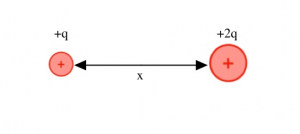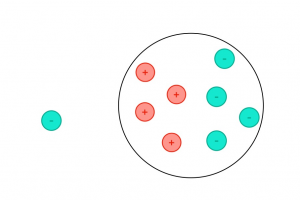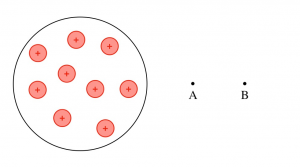Discussion 1: Electric Charge
Instructions: Upload your work as a pdf document. All responses must be typed. Any calculations must be done using Latex, an equation editor, or typed. You can insert diagrams and pictures where appropriate but pictures of your hand written responses and calculations will not be accepted.
Charge Interactions
In figure 1, two positive point charges +q and +2q are separated by a distance x.

- They are both held in place so that they cannot move. What is the direction of the electric forces they exert on one another?
- Describe the magnitudes of the electric forces they exert on one another.
- Explain why they exert these magnitudes on one another.
- What would happen to the magnitudes of the electric forces if the two charges are separated by a distance 2x instead of x?
The ball in the figure is positively charge on one side and negatively charged on the other side. There are equal amounts of positive and negative charge which results in the ball having zero net charge. A negative charge is then placed in the vicinity of the ball.

- How does the ball respond when it is placed near the negative charge as shown in figure 2?
Electric Force and Field
A source of positive charge is held in place as shown in figure 3.

- A positive test charge, q’, is then placed at point A. Draw a vector to represent the electric force exerted by the test charge on the source charge.
- The positive test charge is then moved to point B. Draw a vector to represent the electric force exerted by the test charge on the source charge.
- What can be said of the magnitude the test charge exerts on the source charge at points A and B?
The amount of charge on the test charge is then cut in half and placed again at points A and B.
- Does the electric force it exerts on the source charge change?
- If the electric force does change, then by how much? If it doesn’t change, explain why it doesn’t.
- Does the ratio of the F/q’ change?
- If the ratio does change, then by how much? If it doesn’t change, explain why it doesn’t.
The ratio F/q’ represents the electric field, ![]() .
.
- Compare the magnitude of the electric field when the test charge is placed at point A versus at point B.
- Explain your reasoning for your answer to question 13.
- Draw vectors to represent the electric field when the test charge is placed at points A and B.
- If the amount of charge on the source charge is increased, does the magnitude and/or direction of the electric field at Point A change?
- Why or why not?
- If the amount of charge on the test charge is increased, does the magnitude and/or direction of the electric field at Point A change?
- Why or why not?
- If the test charge was negative instead of positive, does the magnitude and/or direction of the electric field at Point A change?
- Why or why not?
